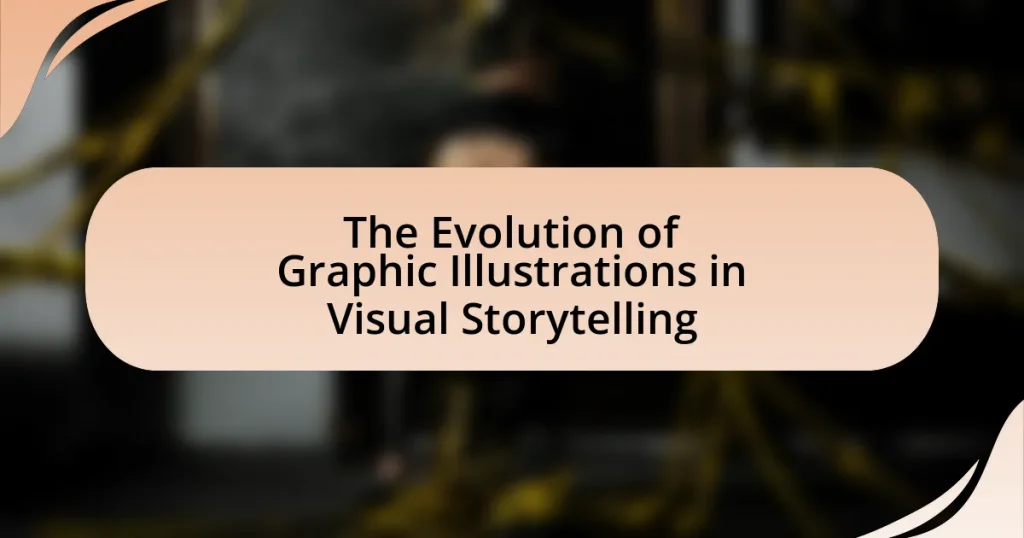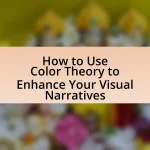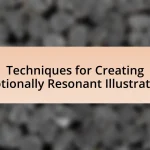The article examines the evolution of graphic illustrations in visual storytelling, tracing their development from ancient cave paintings to contemporary digital art. It highlights key historical milestones, such as the invention of the printing press and the rise of comic books, which have shaped the medium. The discussion includes the impact of technological advancements on illustration techniques, the importance of graphic illustrations in enhancing narrative comprehension and emotional engagement, and the influence of modern trends and digital tools on the industry. Additionally, it addresses common misconceptions, challenges faced by illustrators, and best practices for effective collaboration in storytelling.
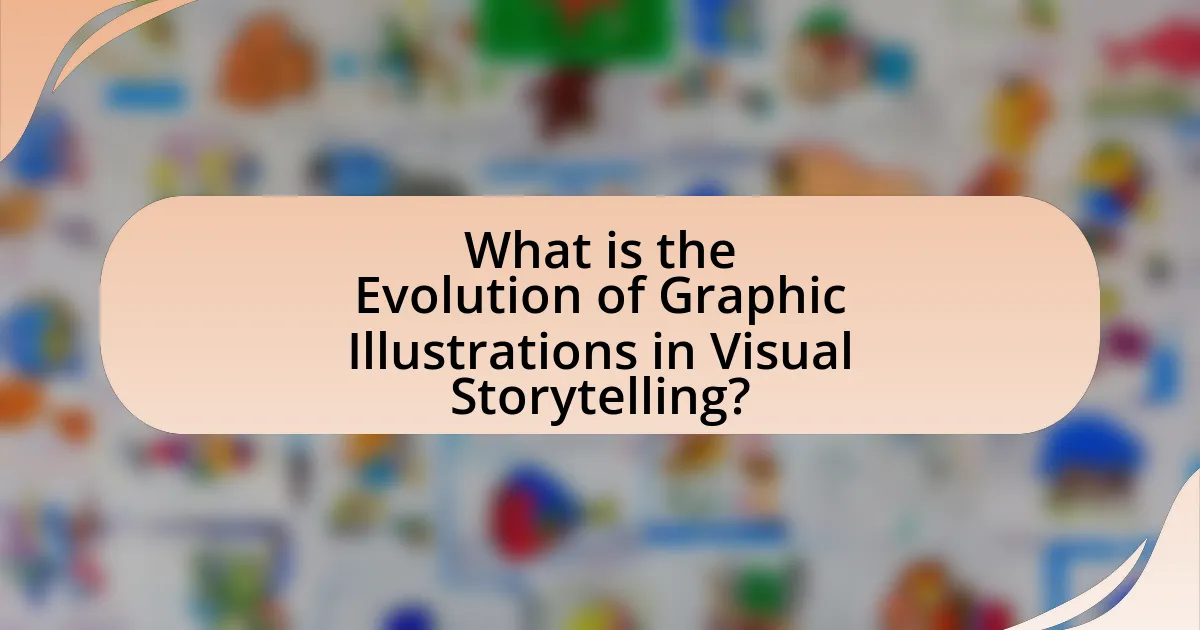
What is the Evolution of Graphic Illustrations in Visual Storytelling?
The evolution of graphic illustrations in visual storytelling has transitioned from ancient cave paintings to modern digital art. Initially, early humans used simple images to convey narratives and document experiences, as seen in the Lascaux cave paintings, which date back approximately 17,000 years. As societies advanced, illustrations became more sophisticated, with illuminated manuscripts in the Middle Ages combining text and imagery to tell religious stories. The invention of the printing press in the 15th century further revolutionized graphic illustrations, allowing for mass production of illustrated books, such as those by Albrecht Dürer.
In the 19th century, the rise of lithography and photography introduced new techniques, enabling artists to create more detailed and realistic illustrations. The 20th century saw the emergence of comic books and graphic novels, which popularized sequential art as a storytelling medium. Today, digital technology has transformed graphic illustrations, allowing for interactive and animated storytelling through platforms like web comics and video games. This progression highlights how graphic illustrations have continually adapted to cultural and technological changes, enhancing their role in visual storytelling.
How have graphic illustrations changed over time in visual storytelling?
Graphic illustrations have evolved significantly over time in visual storytelling, transitioning from traditional hand-drawn techniques to digital formats. Initially, graphic illustrations were primarily created using ink and watercolor, which limited the complexity and speed of production. With the advent of technology, particularly in the late 20th century, digital tools such as Adobe Illustrator and Photoshop revolutionized the field, allowing for greater precision, versatility, and the ability to easily manipulate images.
Furthermore, the rise of the internet and social media platforms has influenced graphic illustrations by promoting a more diverse range of styles and accessibility, enabling artists to reach wider audiences. For instance, webcomics and infographics have gained popularity, showcasing how graphic illustrations can convey complex narratives and data visually. This shift reflects a broader trend towards interactive and multimedia storytelling, where illustrations are integrated with animations and user engagement.
The historical context of these changes highlights the impact of technological advancements on artistic expression, demonstrating that graphic illustrations have become more dynamic and integral to modern storytelling.
What historical events influenced the evolution of graphic illustrations?
The invention of the printing press in the 15th century significantly influenced the evolution of graphic illustrations by enabling mass production of illustrated texts. This technological advancement allowed for the widespread dissemination of illustrated works, such as books and pamphlets, which incorporated woodcuts and engravings. The Renaissance period further propelled graphic illustrations as artists like Albrecht Dürer utilized printmaking techniques to create detailed and expressive images, merging art with literature. Additionally, the rise of advertising in the 19th century introduced new graphic styles and techniques, as illustrated posters and advertisements became essential for marketing products. These historical events collectively shaped the development of graphic illustrations, establishing them as a vital component of visual storytelling.
How did technological advancements impact graphic illustrations?
Technological advancements significantly transformed graphic illustrations by enhancing the tools and methods available for artists. The introduction of digital software, such as Adobe Illustrator and Photoshop, allowed for greater precision, flexibility, and efficiency in creating illustrations. Additionally, advancements in hardware, like graphic tablets and high-resolution monitors, enabled artists to produce more detailed and vibrant images. The shift from traditional to digital mediums has also democratized graphic illustration, making it accessible to a broader audience and facilitating the rise of online platforms for sharing and selling artwork. These changes have fundamentally altered the landscape of visual storytelling, allowing for innovative styles and techniques that were previously unattainable.
Why are graphic illustrations important in visual storytelling?
Graphic illustrations are important in visual storytelling because they enhance comprehension and engagement by conveying complex ideas quickly and effectively. Research indicates that visuals can improve information retention by up to 65% compared to text alone, as illustrated in studies by the University of Minnesota. This effectiveness stems from the brain’s ability to process images 60,000 times faster than text, making graphic illustrations a powerful tool for capturing attention and facilitating understanding in narratives.
What role do graphic illustrations play in enhancing narrative comprehension?
Graphic illustrations significantly enhance narrative comprehension by providing visual context that aids in understanding complex ideas and emotions. These illustrations serve as cognitive tools that help readers visualize characters, settings, and actions, thereby facilitating a deeper engagement with the narrative. Research indicates that visual elements can improve memory retention and comprehension; for instance, a study published in the journal “Educational Psychology” found that students who engaged with illustrated texts performed better on comprehension tests than those who read text-only versions. This demonstrates that graphic illustrations not only complement the written word but also actively contribute to a more effective storytelling experience.
How do graphic illustrations evoke emotions in storytelling?
Graphic illustrations evoke emotions in storytelling by visually representing characters, settings, and events, which enhances the audience’s emotional connection to the narrative. The use of color, composition, and style in illustrations can elicit specific feelings; for example, warm colors may evoke happiness or warmth, while darker tones can convey sadness or tension. Research indicates that visual stimuli can trigger emotional responses more effectively than text alone, as illustrated by a study published in the journal “Cognitive Science,” which found that images can activate emotional centers in the brain, leading to a stronger empathetic response. Thus, graphic illustrations serve as powerful tools in storytelling, facilitating deeper emotional engagement and understanding.
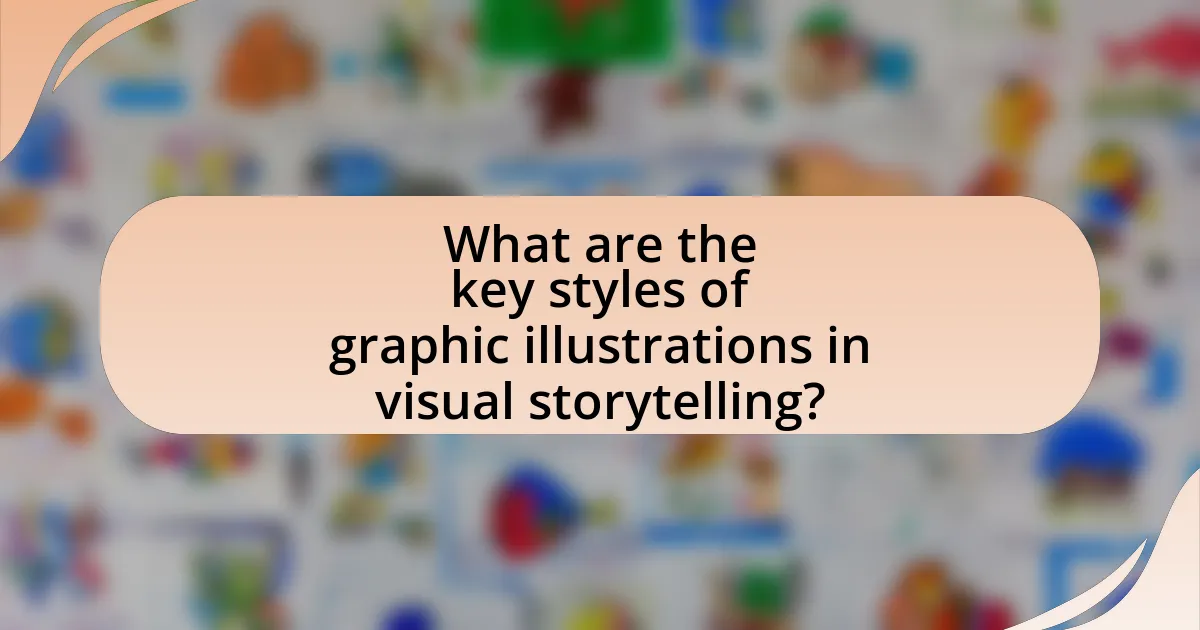
What are the key styles of graphic illustrations in visual storytelling?
The key styles of graphic illustrations in visual storytelling include realism, minimalism, and abstraction. Realism focuses on depicting subjects as they appear in real life, often using detailed imagery to convey authenticity and emotional depth. Minimalism emphasizes simplicity, using limited elements to create a clear and impactful message, often relying on negative space and basic shapes. Abstraction, on the other hand, distorts reality to convey concepts or emotions, allowing for a more subjective interpretation by the viewer. Each style serves distinct purposes in storytelling, enhancing the narrative through visual engagement and emotional resonance.
How do different styles of graphic illustrations affect storytelling?
Different styles of graphic illustrations significantly influence storytelling by shaping the emotional tone, pacing, and audience engagement. For instance, a minimalist style can create a sense of calm and focus, allowing readers to interpret the narrative more personally, while a detailed, intricate style can immerse the audience in a rich, complex world, enhancing the depth of the story. Research indicates that visual styles can evoke specific emotional responses; for example, studies show that bright colors and dynamic lines in illustrations can increase excitement and urgency in storytelling, while muted tones may evoke nostalgia or sadness. Thus, the choice of illustration style directly impacts how a story is perceived and experienced by its audience.
What are the characteristics of traditional graphic illustration styles?
Traditional graphic illustration styles are characterized by their emphasis on hand-drawn techniques, distinct line work, and a limited color palette. These styles often utilize traditional media such as ink, watercolor, and pencil, which contribute to their unique textures and depth. Historically, these characteristics can be traced back to early printmaking methods, where artists relied on meticulous craftsmanship to convey narratives visually. The use of bold outlines and stylized forms is prevalent, allowing for clear communication of ideas and emotions. Additionally, traditional graphic illustrations often reflect cultural and historical contexts, showcasing the artistic conventions of their time, such as the detailed ornamentation seen in Art Nouveau or the simplicity of early 20th-century modernism.
How have modern graphic illustration styles emerged?
Modern graphic illustration styles have emerged through the convergence of digital technology, cultural influences, and evolving artistic trends. The advent of software like Adobe Illustrator and Procreate has enabled artists to experiment with new techniques and styles, leading to a diverse range of visual expressions. Additionally, the rise of social media platforms has facilitated the sharing of illustrations, allowing for cross-cultural exchanges that influence contemporary aesthetics. For instance, the popularity of flat design and minimalism can be traced back to the influence of Scandinavian design principles and the need for clarity in digital interfaces. This blend of technology and cultural exchange has significantly shaped the landscape of modern graphic illustration.
What are the most notable examples of graphic illustrations in visual storytelling?
Notable examples of graphic illustrations in visual storytelling include “The Arrival” by Shaun Tan, “Maus” by Art Spiegelman, and “Persepolis” by Marjane Satrapi. “The Arrival” uses detailed illustrations to convey the immigrant experience without text, effectively communicating emotions and narratives through visuals. “Maus,” a Pulitzer Prize-winning graphic novel, employs anthropomorphic characters to depict the Holocaust, blending history with personal storytelling. “Persepolis” presents a memoir of growing up during the Iranian Revolution, utilizing stark black-and-white illustrations to emphasize the contrast between childhood innocence and political turmoil. These works exemplify how graphic illustrations can enhance narrative depth and emotional resonance in storytelling.
Which graphic novels have significantly influenced the medium?
“Watchmen” by Alan Moore and Dave Gibbons significantly influenced the graphic novel medium by introducing complex narratives and mature themes. Released in 1986, “Watchmen” redefined the superhero genre, showcasing a deconstruction of traditional hero archetypes and incorporating intricate storytelling techniques, such as non-linear timelines and character depth. Another pivotal work is “Maus” by Art Spiegelman, which won the Pulitzer Prize in 1992, blending autobiography with historical narrative to address the Holocaust, thereby elevating graphic novels as a serious literary form. “Sandman” by Neil Gaiman also played a crucial role in expanding the medium’s scope, merging mythology, horror, and fantasy, and demonstrating that graphic novels could explore sophisticated themes and diverse genres. These works collectively established graphic novels as a legitimate and impactful storytelling medium, influencing countless creators and shaping the industry’s evolution.
How have animated films utilized graphic illustrations effectively?
Animated films have effectively utilized graphic illustrations by enhancing storytelling through visual aesthetics and emotional engagement. For instance, films like “Spider-Man: Into the Spider-Verse” employed a unique blend of comic book styles and dynamic visuals to create a vibrant narrative experience, which resonated with audiences and critics alike. This innovative approach not only captivated viewers but also won the Academy Award for Best Animated Feature in 2019, demonstrating the impact of graphic illustrations on the medium. Additionally, the use of color palettes and character designs in films such as “The Lion King” and “Frozen” has been shown to evoke specific emotions, further solidifying the role of graphic illustrations in conveying complex themes and narratives effectively.
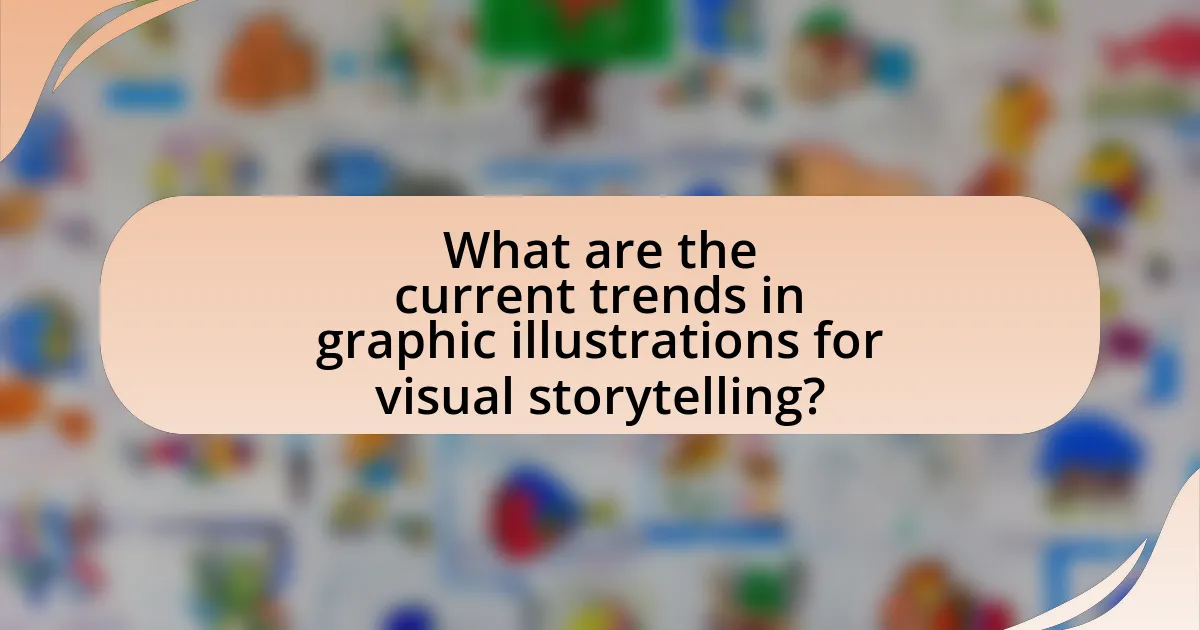
What are the current trends in graphic illustrations for visual storytelling?
Current trends in graphic illustrations for visual storytelling include the use of bold colors, minimalistic designs, and dynamic typography. These elements enhance engagement and convey messages more effectively. For instance, the rise of digital platforms has led to an increased preference for vibrant, eye-catching illustrations that stand out in crowded feeds. Additionally, the trend towards minimalism allows for clearer communication by stripping away unnecessary details, making the core message more accessible. Furthermore, dynamic typography is being integrated into illustrations to create a more interactive experience, drawing viewers into the narrative. These trends reflect a shift towards more visually compelling and easily digestible content in the realm of storytelling.
How are digital tools shaping the future of graphic illustrations?
Digital tools are revolutionizing graphic illustrations by enhancing creativity, efficiency, and accessibility. Software such as Adobe Illustrator and Procreate allows artists to experiment with various styles and techniques, enabling the creation of intricate designs that were previously time-consuming or impossible with traditional methods. Furthermore, the rise of vector graphics and 3D modeling software has expanded the possibilities for visual storytelling, allowing for more dynamic and engaging illustrations. According to a report by Statista, the global graphic design market is projected to reach $249 billion by 2025, highlighting the increasing reliance on digital tools in the industry. This shift not only democratizes the field, making it easier for aspiring artists to enter, but also fosters innovation as creators leverage technology to push the boundaries of visual communication.
What software is commonly used for creating graphic illustrations today?
Adobe Illustrator is commonly used for creating graphic illustrations today. This vector graphics software is favored by professionals for its robust features, including advanced drawing tools, typography options, and compatibility with other Adobe Creative Cloud applications. According to a survey by the Graphic Artists Guild, over 70% of graphic designers reported using Adobe Illustrator as their primary tool for illustration work, highlighting its industry standard status.
How do social media platforms influence graphic illustration trends?
Social media platforms significantly influence graphic illustration trends by providing a space for rapid sharing and feedback, which accelerates the dissemination of styles and techniques. For instance, platforms like Instagram and Pinterest allow artists to showcase their work to a global audience, leading to the emergence of viral trends such as minimalism and retro aesthetics. According to a study by the Pew Research Center, 72% of adults use social media, which amplifies the visibility of popular graphic styles and encourages artists to adapt their work to align with trending visuals. This dynamic interaction between artists and audiences fosters a continuous evolution of graphic illustration trends, as creators respond to the preferences and feedback of their followers.
What challenges do graphic illustrators face in visual storytelling?
Graphic illustrators face several challenges in visual storytelling, including the need to convey complex narratives succinctly and effectively. This requires a deep understanding of both the subject matter and the audience’s perspective. Additionally, illustrators must balance creativity with technical skills, ensuring that their artwork aligns with the intended message while adhering to industry standards. Time constraints often exacerbate these challenges, as illustrators must produce high-quality work within tight deadlines. Furthermore, the evolving nature of digital platforms demands adaptability, as illustrators must stay updated with new tools and trends to remain relevant in a competitive market.
How do copyright issues affect graphic illustrations?
Copyright issues significantly impact graphic illustrations by restricting the use, reproduction, and distribution of artistic works. These legal protections ensure that creators retain control over their illustrations, which can lead to limitations on how others can utilize these images in various media. For instance, unauthorized use of copyrighted illustrations can result in legal disputes, financial penalties, and the need for licensing agreements. According to the U.S. Copyright Office, copyright protection is automatic upon the creation of an original work, which underscores the importance of respecting intellectual property rights in the graphic arts. This legal framework not only safeguards the interests of artists but also influences the availability and accessibility of graphic illustrations in visual storytelling.
What are the common misconceptions about graphic illustrations?
Common misconceptions about graphic illustrations include the belief that they are solely decorative elements, that they require advanced technical skills, and that they lack depth or meaning. Many people think graphic illustrations are merely embellishments, but they serve critical roles in communication, enhancing understanding and engagement. Additionally, while some graphic illustrations may require technical expertise, many effective illustrations can be created using basic tools and concepts, making them accessible to a wider audience. Lastly, the notion that graphic illustrations lack depth is inaccurate; they can convey complex narratives and emotions, as evidenced by their use in storytelling across various media, including books, films, and digital platforms.
What best practices should graphic illustrators follow in visual storytelling?
Graphic illustrators should prioritize clarity, coherence, and emotional engagement in visual storytelling. Clarity ensures that the message is easily understood by the audience, while coherence maintains a logical flow that guides viewers through the narrative. Emotional engagement connects the audience to the story, making it more impactful. Research indicates that visuals can enhance memory retention by up to 65%, demonstrating the importance of effective visual communication in storytelling. By adhering to these best practices, graphic illustrators can create compelling narratives that resonate with their audience.
How can illustrators effectively collaborate with writers and filmmakers?
Illustrators can effectively collaborate with writers and filmmakers by establishing clear communication and shared vision from the outset. This involves regular meetings to discuss concepts, themes, and visual styles, ensuring that all parties are aligned on the project’s goals. For instance, the use of storyboards can facilitate a visual dialogue, allowing illustrators to translate narrative elements into imagery that complements the script. Additionally, feedback loops are essential; illustrators should seek input from writers and filmmakers throughout the creative process to refine their work and ensure it meets the narrative’s needs. Research indicates that successful collaborations often result from a mutual understanding of each other’s roles and contributions, enhancing the overall storytelling experience.
What techniques enhance the impact of graphic illustrations in storytelling?
Techniques that enhance the impact of graphic illustrations in storytelling include the use of color theory, composition, and visual metaphors. Color theory influences emotions and can evoke specific feelings, while effective composition guides the viewer’s eye and emphasizes key elements of the narrative. Visual metaphors create deeper connections by representing complex ideas through imagery, making the story more relatable and engaging. Research indicates that illustrations that effectively combine these techniques can significantly improve audience retention and comprehension, as demonstrated in studies on visual learning, such as those conducted by Mayer and Moreno in 2003, which highlight the cognitive benefits of integrating visuals with text in storytelling.
